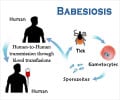Role of key protein to facilitate RNA-based interactions between malarial parasite, its mosquito vector, and its human host.

‘Since the malaria parasite cannot anticipate when it may be transmitted from a mosquito to a mammalian host, it uses specialized poly (A)-binding proteins to package and protect its genetic material for use after transmission.’





During this process, called translational repression, special proteins bind to mRNAs and prevent them from being translated into protein. One protein involved binds to the mRNA’s poly(A) tail -- a repeated string of As or adenosine molecules added to the end of most mRNA strands. This helps to form a complex of proteins and RNA that is silenced but poised for action after the parasite is transmitted to the host. Most single-celled organisms have one type of this poly(A)-binding protein, while multi-cellular organisms have two. In this study, the researchers characterize two types of poly(A)-binding proteins in the single-celled Plasmodium parasite, both of which contribute to translational regulation. "We knew from our lab’s previous work that Plasmodium had a type of poly(A)-binding protein that functions outside of the nucleus of the cell," said Allen Minns, research technician at Penn State and first author of the paper. "This protein binds and protects the poly(A) tail at one end of an mRNA strand. In this study, we used biochemical approaches to further characterize this protein, and found that it also has a specialized job receiving mRNAs. It forms chains without the presence of RNA, which potentially allows large assemblies of the protein to quickly protect the entire length of the poly(A) tail."
The researchers also identified and characterized a second type of poly(A)-binding protein that functions inside the nucleus of the parasite during the blood stages of its life cycle. In multi-cellular organisms, this second poly(A)-binding protein usually performs a quality control check before mRNA exits the nucleus, confirming that the mRNA is constructed properly. These quality control proteins then pass on the mRNA strand to other proteins outside of the nucleus, which direct the mRNA to be translated or to be packaged for later use through translational repression.
In addition to an important role in translational regulation inside of the cell, the researchers also discovered that the non-nuclear poly(A)-binding protein may play a surprising role outside of the cell.
Role of poly(A)-binding protein outside the cell
Advertisement
The researchers speculate that the poly(A)-binding proteins on the sporozoite surface allow the parasite to interact with RNA from sources outside of the parasite and could thus provide an opportunity for the parasite to interact with the mosquito or the host through their RNA.
Advertisement
Source-Eurekalert














